| |||||||
| Anthem | "The light of Rome" | ||||||
| Capital | Constantinople | ||||||
| Largest city | Constantinople | ||||||
| Other cities | Antioch, Sinope, Trebizond, Nicaea, Nicomedia, Hadrianople, Athens, Thessaloniki, Ragusa, Sedirca, Naples, Syracuse | ||||||
| Language official |
Greek | ||||||
| others | Armenian, Turkish, Arabic, Bulgarian, Serbian, Croatian | ||||||
| Religion main |
Byzantine Orthodox (Eastern Orthodox) | ||||||
| others | Sunni, Shia, Protestant, Catholicism, Eastern Catholic, Neo-Greek Paganism, Assyrian Christianity, Coptic Christianity | ||||||
| Ethnic Groups main |
Greek | ||||||
| others | Armenians, Arabs, Turks, Serbs, Italians, Syrians, Georgians, Bulgarians, Romanians, Kurdish | ||||||
| Government | Constitutional Monarchy | ||||||
| Legislature | Senate of Constantinople | ||||||
| βασιλεύς (Basileus) | Andronikos XIV | ||||||
| Ruling Family: | Doukas | ||||||
| Consul | Constantine Angelos | ||||||
| Population | 53,405,432 | ||||||
| Established | 324 CE | ||||||
| Currency | Phantis (Ph) | ||||||
| The following Hail Byzantium Basileia Rhomaion is under construction.
Please do not edit or alter this article in any way while this template is active. All unauthorized edits may be reverted on the admin's discretion. Propose any changes to the talk page. |
The Byzantine Empire is the remnants of the roman empire and has survived into the 21st century. It had survived the storm of Arab and Turk invasions and has thrived ever since Isaac II began the Byzantine reconquests reversing the effects of the Turkification of Anatolia.
Origins[]
The Byzantine empire originated in the old Roman Empire. It was formed a de facto in 285 CE and in 294 CE a de jure. Its capital originally in Nicomedia under Diocletian however in 324 CE Constantine had abolished the system of Tetrachy under Diocletian and established his capital in the former city of Byzantium, which the empire gets its name from.
Division of the Empire[]
After the death of Jovian, the empire was divided on his death, to which the Valentinian Dynasty took over and divided into two empires. it was briefly reunited under Theodosius I however after his death, the empire was split never to be reunited again
The loss of the west[]
While the east prospered, the west fell into anarchy. Multiple usurpers claimed the throne in the west however with an increasing reliance on the foreign mercenaries, the city of Rome finally fell in 476 CE with the imperial purple being sent to Constantinople to show that there would be no longer rule in the west. However there were some remnant territories survived. the domain of Soisson survived until the frankish king annexed into his territory, the Western Roman Empire in Dalmatia survived until 480 CE when the last emperor in the west Julius Nepos was assassinated, and the roman moor kings survived until the Byzantines reconquered North Africa, their territories being reincorporated into the Byzantine empire as the Exarchate of North Africa.
Justinian's reconquests[]
Justinian was the son of a farmer, and had secured himself as emperor of the east in 527 CE. After surviving the Nika Riots, he planned to reconquer the west and restore the Roman Empire in Rome. He sent his most accomplished general Belasarius, who had defeated the Persians at the battle of Dara. Belasarius successfully subdued the Kingdom of the Vandals, and then went to seized Italia from the goths, however Justinian's dreams would only hinder the empire's ability to defend itself.

After the Arab invasions, the Byzantines lost most territory to the Magyars, the Bulgars, the Lombards and the Visigoths
Arab invasions[]
However Justinian's reconquests had overstretched the empire. After emperor Heraclius had successfully defeated the Sassanids, the Rashidun Caliphate quickly filled the vacuum of the two weakened states successfully conquering most of Sassanid territory and most of Byzantine territory. During the 7th and 9th century, Byzantine lands were constantly raided and nearly buckled the weight of the Arab Caliphates, however the light of rome would not die so soon...
Bulgar invasions and the fall of the Bulgarian Empire[]
With the Arabs swallowing up Byzantine territory, the bulgars took the advantage of the failing Byzantine Empire and established the Bulgarian Empire in the balkans. They took most of the Balkans except for territories in Morea, Thessaloniki and Thrace. However the Byzantines managed to push them back in the late 900s prompting the end of the Bulgarian culture and the assimilation into Byzantine Greek culture, the empire finally fell in the early 11th century in 1018 following Basil II victory.
Byzantine resurgence[]
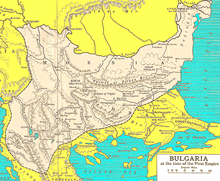
The Bulgars during the 10th century
Following the 20 years anarchy, the Makedonian basilieus' started to recapture territory for the Byzantine Empire. This began with campaigns against the declining Abbasid caliphate reclaiming Antioch, Crete, and Cyprus from the Arabs. Then under Basil II, the greatest of the Makedon dynasty, he conquered all of Bulgaria restoring much of the Byzantine empire. However like Justinian before him, he left the coffers of the empire empty and for his successor to pick up the pieces...
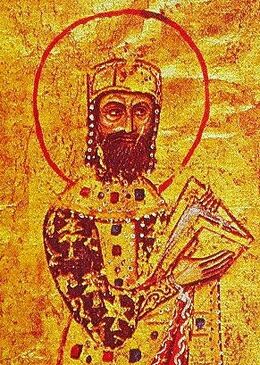
Alexios I Komnenos, saviour of the Roman Empire
The Seljuks, the crusades, and Alexios I[]
With the Normans retaking Byzantine Sicilian territory, and the Seljuks bearing on the Byzantines in Anatolia after the defeat of the Romans in Manzinkert, it was only a matter of time before the glory of Rome would fade from existence. However a energetic new emperor Alexios I, began what is known as the Komnenion Resurgence. Asking for latin support in Rome, Alexios I managed to co-ordinate a crusade with Pope Urban II to the holy, with the Crusaders keeping the Seljuks busy, Alexios managed to recapture much territory lost by the Seljuks.
Komnenoi[]
After Alexios, his successors tried to restore much of the territory, despite John II having little success, but good fortune was furthered by Manuel Komnenos, who campaigned in the west securing territory in Serbia and gaining land from the Seljuks, however later in life, he tried to capture Sicily from the Normans. However he is regarded as one of the many great Komnenoi.
Isaac II's triumph[]
Alexios II Komnenos ascends the throne under the regency of empress Maria I, however many greek lords resent the rule of empress maria for latin leanings. In response, Andronikos I tried to seize the throne but is betrayed by his muslim contingent who massacred his forces leaving the rest of the rebellion to be crushed. This was all due to the efforts of Isaac Angelos (who is then renamed a Komnenos) and goes on a military campaign against the sultanate of Rum seizing much of Rum territories and preventing the Sultanate of Rum from seizing power in anatolia ever again. When Alexios rose absolute power, he ordered Maria to be executed under the guidance of Isaac Angelos and soon tasked Isaac to retake Anatolia from the turks. Under Isaac, this was an astounding success retaking nearly all Anatolian territory. He was proclaimed heir in the case that Alexios II died and was named a legitimate member of the Komnenos family. Soon after at the age of 20 Alexios II dies in 1189 CE leaving Isaac II Komnenos as emperor. His first order of business was the crusaders. Emperor Barbarossa of the Holy Roman Empire requested access and money for the third crusade. Although initially denying it, seeing the benefits of the latins under Manuel I rule, he proceeded to allow further venetian trading in the Byzantine empire creating more income for the empire and warming relations with the Venetians. His first internal challenge came from Andronikos I who proclaimed himself king of cyprus after Isaac's ascension to the throne. After defeating Andronikos, who was killed in a peasant uprising due to his inefficient administration. Isaac II made decision to join the crusades to recapture Anatolian territory further mending church relations. Isaac's decision was quite shocking as this was the first time a byzantine emperor decided to participate in a crusade, The crusade was an astounding success, recapturing all lost territory and bringing the komnenian restoration to full fruition. He however, evacuated much of west balkan territory deeming it undefendable. This allowed Isaac II to recapture all of Anatolian territory during the third crusade.

Isaac II Komnenos (Angelos), prevented the very common Byzantine Usurpations
Isaac II's success was partly due to his handling of the Latins and the conspiring nobles. The Byzantine bureaucracy before the war of 5 emperors was relatively unstable and many emperors had met their end from usurpation. However Isaac II by a miracle managed to stop conspiring nobles from ending Alexios II, prevented Alexios' mother from destroying the empire, stopped Andronikos I from seizing the throne and successfully pushed back the Seljuks without jeopardising the Byzantine Treasury.
Alexios IV, Manuel II Laskaris and the Trebizond Empire[]
In 1206 Isaac II died leaving his son Alexios IV "the great" as emperor. Although Alexios IV's uncle (Alexios III) brought a small army to the walls of Constantinople, eventually Alexios III was cut down by his own troops and pledged loyalty to Alexios IV. Alexios IV like his father was a military genius, and finished the conquest of anatolia finishing of the weak and enfeebled seljuk sultanate of rum in 1241 when the threat of the mongols came. Eventually in 1250, when Alexios IV died, he proclaimed his brother in law Manuel II Laskaris to succeed him. However his father's former advisor and son-in-law John Komnenos proclaimed himself emperor at took control of Trebizond and the surrounding region. Manuel II was deemed incapable by many, however he managed to defeat an invasion from the Seljuks in 1253 and prevented an incursion by Crusaders. However by 1258, the Trebizond Empire was putting a stain in Manuel's credibility and was about to fall victim to court intrigue. He and Michael VIII Palaiologos, his trusted advisor set out with 20,000 men to end the Trebizond Empire under John Komnenos. Manuel had arrived on the field supported by an extra 3000 Turkish mercenaries facing of John who surprisingly could muster 26,000 men from the Trebizond Empire. Manuel marched out as it seemed by John, to attack headlong into the strong Trebizond infantry with bulk of his forces however there were no cavalry to be seen. And Manuel had only 1000 Turkish infantry. It seemed John was destined to win and finally claim the Byzantine throne. But out of nowhere 8000 cavalry drove into the weak parts of John's Army. Manuel then moved the rest of his mean into the demoralised enemy crushing them and John barely escaped with 10,000 of his mean. The victory was a miracle, and soon Manuel II was given more support. However, Manuel II contracted a disease that proved to be fatal. He left no successor and left Byzantium on a knife's edge.
Michael VIII Palaiologos Ascension and campaigns in Sicily[]
Michael VIII ascended the throne in 1259 CE after the Komnenos-Angelos line was extinguished after Manuel II left no clear successor. At the time when usurpations were common, by a miracle and by Michael's ingenuity, he avoided court intrigue and secured his family as emperor and secured the loyalty of the greek lords and his family.
Michael VIII was very ambitious. With all of Byzantine territory restored, Michael VIII reinstated the Theme system. With the Theme system, he made lords have more say in the decisions of the empire. In each theme maintain a force of 2000-10,000 men on top of the lords forces. With the permission of the emperor the lord could use these forces on top there own private forces. The emperor call upon certain themes to provide their standing force for a campaign. This left a fresh supply of troops to reinforce the emperor's personal forces.
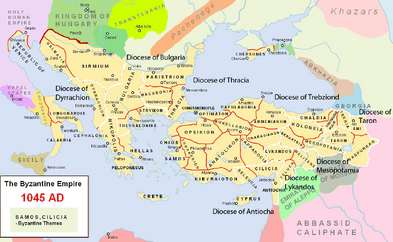
Territory regained to pre-1071 - The Theme of Antiochia, Mesopotamia, Lykandos, Taron, Trebizond, Thracia, Bulgaria, Dyrrachion
The emperor could also go on campaigns without worrying about defence. The lords under the will of the emperor could group certain defensive areas where they are obligate to reinforce frontier forces. For example a lord who controls the Theme of Sebasteia is obliged to support the Doukos of Mesopotamia. As well as the emperor requesting troops from a theme within a diocese.
Michael VIII reforms gave more room for him to go on more campaigns and it also laid the foundations for a modern Byzantine army.
His first order of business was the crimea. He sent small raiding forces under the local Doukos to subdue the local tribes.
Then he proceeded to establish a foothold on Norman Sicily. After successfully taking Syracuse, and Lecce he then proceeded to take Cosenza. However after meeting up with the rest of his forces, he faced down a force of 20,000 Normans which he had 40,000 men from Nikopolis, Hellas, Thessalonike and Chios. The Normans put up a stubborn defence and were easily defeated.
With the enclaves in Sicily secure, Michael VIII travelled back to Constantinople to manage trade with the Venetians. Michael VIII was a firm believer in trade and with Venetian agreements, he built up the coffers of the empire. after 1279 he survived for 4 more years until he died in 1282 on the 29th of December. Michael was also known to have funded Marco Polo's journey to China.
The Norman Slayer[]
Michael VIII's son Andronikos II "The Norman Slayer" Palaiologos became emperor in 1282. Andronikos II wasn't content in holding just the enclaves in Sicily. Andronikos started to capture the rest of the Sicily. At the time king Charles the 1st was ruling at age 59. However Andronikos II could only spare troops from Hellas, Samos and Chios as the other Diocese and Themes were busy fighting Seljuk incursions and Golden Horde incursions.
Andronikos II had only 15,000 men and an extra 2000 from the two Italian enclaves as Syracuse was busy fighting the Alhomads who had recently taken over most of southern Sicily. Andronikos II set out against the Normans outside Taranto and captured the city without a fight and set off to Naples. Charles had 20,000 men and the support of the Crown of Aragon.
It seemed like Andronikos was going to lose however he managed to slaughter 10,000 of Charles I's men at the battle of Salerno. He could not however defeat the Normans had to reinforce his forces around Taranto and Potenza as well as relieving the siege of Syracuse by the Alhomads.
The next year few years from 1284-1295, Andronikos II captured all of Sicily from the Berbers and the Normans. Andronikos II's next goal was to seize the rest of Sicily from the Sicilian king, now a relative from the house of Barcelona. On June the 9th 1308, Andronikos II sailed the Byzantine navy into Naples destroying the Sicilian navy at anchor and launched an assault via the Harbour, for the next few days, the Normans defected to Byzantium, and on July the 27th 1308 CE, the King of Sicily was executed and the ruler was replaced by a defected Norman who had called himself Alexios Laskarid, and he was named Despotes of Sicily.
Andronikos II returned to Constantinople a hero, he spent the rest of his life dealing with the Italian city states filling the coffers of the empire like his father Michael VIII. He died on January 30th 1328 at age 65.
Staurakios II "The Bulgar"[]
Staurakios II was born on September the 8th 1293 in Nicopolis Bulgaria. Being the brother of Andronikos II, he was well regarded by many in the Byzantine court and was favoured, making his reign fairly stable. Crowned in 1328 after his brother's death, he was known to be very hostile in foreign politics. Looking to end the dominance of the fat venetian traders, in 1331 he lead a raid into Venetian held Ragusa, looting it for valuables and the capturing the city the next day. Staurakios II's brother John III "The Serbian" was made despotes of Ragusa and the Doukos of Dyrrachion. This had significant side effects and Staurakios was becoming unpopular the year 1336, just 2
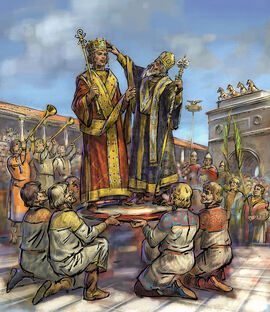
Staurakios II "The Bulgarian" seen as one of the more hostile of the Byzantine Emperors and is regarded as an ineffective ruler despite ending Venetian Trade dominance
years after his victory in Ragusa. He used the looted wealth to create public works however a coup in 1337 by Staurakios III his brother threatened the very empire itself.He abdicated just as his son had returned from Corduba just as Staurakios "the Wrathful" marched to siege Adrianople.
Staurakios II spent the rest of his life living as a monk in Thessaloniki and died peacefully in 1340 CE.
Romanos V "The Trader"[]
Romanos V was an unusual emperor. Son of Staurakios "The Bulgar", he spent most of his early years travelling to the various muslim cities and had studied in Baghdad in 1331. He was crowned emperor in 1337 after his father died naturally. While his reign was stable, he faced a rival claimant, his uncle Staurakios III "The Wrathful". Staurakios had initially found support among hardliner greek lords in Hellas and Peloponesus, and marched on Constantinople. Little did he know that Romanos had allies that were ready to cut down Staurakios III. Romanos V's loyal uncle John III "The Serbian" had been plotting with Romanos V to end Staurakios when the moment was right.
In 1340 CE, John "The Serbian" led his troops and had killed Staurakios III in the middle of the night and declared their official loyalty to Romanos. Romanos V had awarded John by making him Megadoukos of the Byzantine Empire and Despotes of Sicily after the previous Despotes had joined with Staurakios III in revolt. Under Romanos, he began a huge rapprochement with the Venetians. He also began moving away from the very antagonistic relations with the Seljuks and other Sultanates. He began trading with these nations and had refilled the coffers of the treasury that his father had previously emptied during his war with Venice.
In 1350 CE Romanos V had grown tired of court life, and abdicated in favour of his brother Nikephoras IV.
Nikephoras IV "Purple born"[]
Nikephoras IV ascended the throne in 1350 CE after Romanos V abdicated and spent the rest of his life travelling to China and living there.
Nikephoras moved away from the endless war and foreign politics and moved to a more religious life and funded many cultural arts and began the Byzantine renaissance.
His reign was relatively peaceful and had for the first time had reigned peacefully since the days of the early Byzantine Empire. He had successfully integrated most Bulgarians as true Byzantines and greeks, he had reversed the Turkification and turned Anatolia again into a fertile land.
After ruling for 28 years, Nikephoras IV died quietly in Constantinople, little did he know that the largest power struggle would nearly rip the empire apart after his death.
War of the Five empires[]
The war of the five empires was the last of the great dynastic struggles that pitted the whole of the Byzantine empire into complete anarchy. Although their were no usurpation akin to the 20 years anarchy, this war is one of the greatest Byzantine Civil wars in history.
The war was fought between five emperors, each with their own ambition to rule the Byzantine Empire or declare independence. It was fought by:
Andronikos III and Basil III
(Their son's Andronikos IV and Basil IV)
Michael IX
John IV
Alexios V
Ivan Shishman
In the end, Andronikos IV was crowned emperor and restored the empire. He retook Bulgaria, prevented the usurper John IV, destroyed the trade empire of Cyprus and destroyed the remnants of the Trebizond empire. This partly due to the success of both Andronikos and Basil IV in both battle, campaign and in politics. They secured an alliance with Venice, mending relations and then by doing that they filled the coffers of Byzantium's treasury, and bringing glory back into the true roman empire.
Basil IV and the Ottomans[]
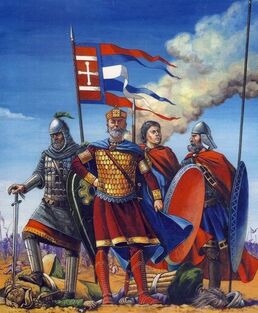
Basil IV "The Deceiver" Known for his skill to outwit his enemies, he also was an expert politician outwitting his rivals and enemies and securing favourable alliances and trade agreements with Venice and the Ottomans
With the Byzantine empire finally secured, Basil IV could focus externally. With an even stronger navy he began to assert his dominance over the Alhomads and the Genoans. In 1420 he elevated the Venetians as favourable traders reasserting them as a major power despite the Byzantines beating them at trade. However a new power was growing in the south. The Ottomans, originally vassals of the Seljuk sultanate of Rum, had evacuated from Anatolia and headed for the fertile Levant foreseeing Byzantine resurgence under Isaac II. They quickly rose to power destroying much of the Seljuk sultanate's former power.
Basil IV seeing the power of the Ottomans used this to his advantage. While striking a favourable trade deal for both Byzantium and the Ottoman Sultanate, he secretly funded the ottomans to strike against the coastal crusader states, while the Byzantines would send mercenaries to raid and pillage the remaining crusader states. By 1429 in the last year of Basil IV's successful reign, both Murad II and Basil IV successfully reduced the crusader states to small enclaves with the exception of county of Tripoli. Like Basil I and II, Basil the IV successfully ruled the Roman Empire.
Byzantium's Era of Peace[]
After the death of Basil IV, for the first time since the time of Hadrian and Marcus Aurelius did the empire
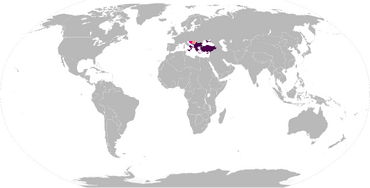
The Byzantine Empire in the 1470s, with the Despotate of Serbia, staunch allies of the Byzantines, and both culturally similar, and the Kingdom of Croatia, now buckling under pressure from both Venetian, Serbian and Byzantine domination
experience peace. During this time Romanos VI ruled from 1430 after a brief interregnum to 1443 where he tried to help preserve the crusader forces. He granted the islands of Linosa and Lampedusa to the Knights of St. John in 1446. His reign was followed by John V who reversed the support of the crusaders and after a campaign against the Ottomans and eventually a treaty that prevented Ottoman raiding into Byzantine territory, he decided that the crusader kingdom of Jerusalem needed to be destroyed and supported Sultan Mehmed 'The Conquerer' in taking Jerusalem by providing the Varangian guard during the assault on the city's walls. He later took the city of Tripoli and handed it over to Mehmed finishing the crusader states in the holy land. After John died in 1463 AD, the Byzantines remained silent in foreign affairs, with Basil V (1463-1479 AD) and Basil VI (1479-1503 AD) strengthening infrastructure in the empire and building new forts on the empire's frontier. Isaac III ascended the throne in 1503 CE and sought to reform the empire. First was regarding the situation with Georgia. The Kingdom of Georgia had been defunct for some time since Basil IV had taken the lands of the Georgian kingdom for the Byzantine Empire. As such the greek noble in charge of the Despotate of Georgia was killed during an uprising. With the Georgians rebelling, Isaac traveled with the Varangian guard, to Georgia and in the process, put Alexios Doukas of Nikomedia in charge of maintaining the empire while was away. With the rebellion swiftly put down, Isaac put a Georgian noble in charge and released Georgia as an autonomous principality. Serbia was then given more freedoms morphing from a semi-autonomous to autonomous despotate in the Byzantine Empire under a loose vassalage to the empire but ran its own affairs and could defend it's own borders. And finally the stagnating themata system was re-organised with the shuffling of new themes and the merging of the theme of Sicily and the theme of Calabria into the Exarchate of Sicily as well as the establishment of a semi-autonomous exarchate of Mesopotamia.
The return of the Doukid dynasty and the new world[]
Alexios VI (1537-1566 AD) was the only son of Isaac III, and by now the Palaiologoi line was almost extinct, Alexios VI spent much of his years campaigning with the Serbian Despotate against the Hungary and later had. He only had one daughter and had no concern for the success of his family name. With no clear successor, he married his daughter to Staurakios IV (1566- 1607 AD) Doukas effectively ending the Palaiologoi line. Staurakios sought to use the might of the Byzantine navy which had just been updated with new cannons, and was coupled with the traditional greek fire. In 1577 AD the Byzantine navy which had just declared war on Castille sailed to the Castillan fleet near Vigo and defeated the Castillan ships, and then proceeded to burn the rest of the fleet at anchor. With the threat of the Castillan fleet, he assembled colonist to sail to the Castillan colonies in the West Indies and seized them from the french all the islands held by the Castillan from Dominique Northwards and seized the Virgin Islands as well as Puerto Rico from the Castillans.



